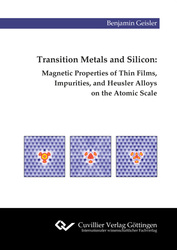| Areas | |
|---|---|
| Serie de libros (96) |
1378
|
| Nachhaltigkeit |
3
|
| Gesundheitswesen |
1
|
| Letra |
2364
|
| Ciencias Naturales |
5406
|
| Matemática | 229 |
| Informática | 319 |
| Física | 980 |
| Química | 1363 |
| Geociencias | 131 |
| Medicina humana | 243 |
| Estomatología | 10 |
| Veterinaria | 108 |
| Farmacia | 147 |
| Biología | 835 |
| Bioquímica, biología molecular, tecnología genética | 121 |
| Biofísica | 25 |
| Nutrición | 45 |
| Agricultura | 1004 |
| Silvicultura | 201 |
| Horticultura | 20 |
| Ecología y conservación de la tierra | 148 |
| Ciencias Ingeniería |
1793
|
| General |
98
|
|
Leitlinien Unfallchirurgie
5. Auflage bestellen |
|
Erweiterte Suche
Transition Metals and Silicon (Tienda española)
Magnetic Properties of Thin Films, Impurities, and Heusler Alloys on the Atomic Scale
Benjamin Geisler (Autor)Previo
Indice, PDF (48 KB)
Lectura de prueba, PDF (170 KB)
The present, richly illustrated book takes the reader on a tour through the field of modern spintronics, discussing key aspects such as ferromagnetic thin films, dilute magnetic semiconductors, and magnetic tunnel junctions. It demonstrates different approaches to a detailed understanding of magnetism and materials properties on the atomic scale, as required by the ongoing miniaturization of electronics. Due to their technological relevance, the focus lies on silicon and different transition metals like chromium, manganese, and iron.
Among others, the following questions are addressed from the viewpoint of state-of-the-art computational physics: Is the scanning tunneling microscope capable of resolving even complex film atomic structures? How can we use its spin-sensitive form to gain insight into interactions of magnetic impurities in bulk semiconductors? Why is chromium-doped silicon especially interesting? Does one need a Seebeck coefficient to obtain spincaloric properties ab initio?
| ISBN-13 (Impresion) | 9783954049448 |
| ISBN-13 (E-Book) | 9783736949447 |
| Formato | B5 |
| Idioma | Inglés |
| Numero de paginas | 236 |
| Laminacion de la cubierta | Brillante |
| Edicion | 1. Aufl. Hardcover |
| Lugar de publicacion | Göttingen |
| Lugar de la disertacion | Duisburg-Essen |
| Fecha de publicacion | 12.03.2015 |
| Clasificacion simple | Tesis doctoral |
| Area |
Física
Física de materia condensada ( incluyendo física de cuerpos solidos, optica) |
| Palabras claves | magnetism, silicon, transition metals, silicides, Heusler alloys, spin-polarized scanning tunneling microscopy, density functional theory, hybrid functionals, electronic correlations, spintronics, spincalorics, surfaces, interfaces, thin films, dilute magnetic semiconductors, impurity clusters, magnetic organic molecules, magnetic tunnel junctions |








